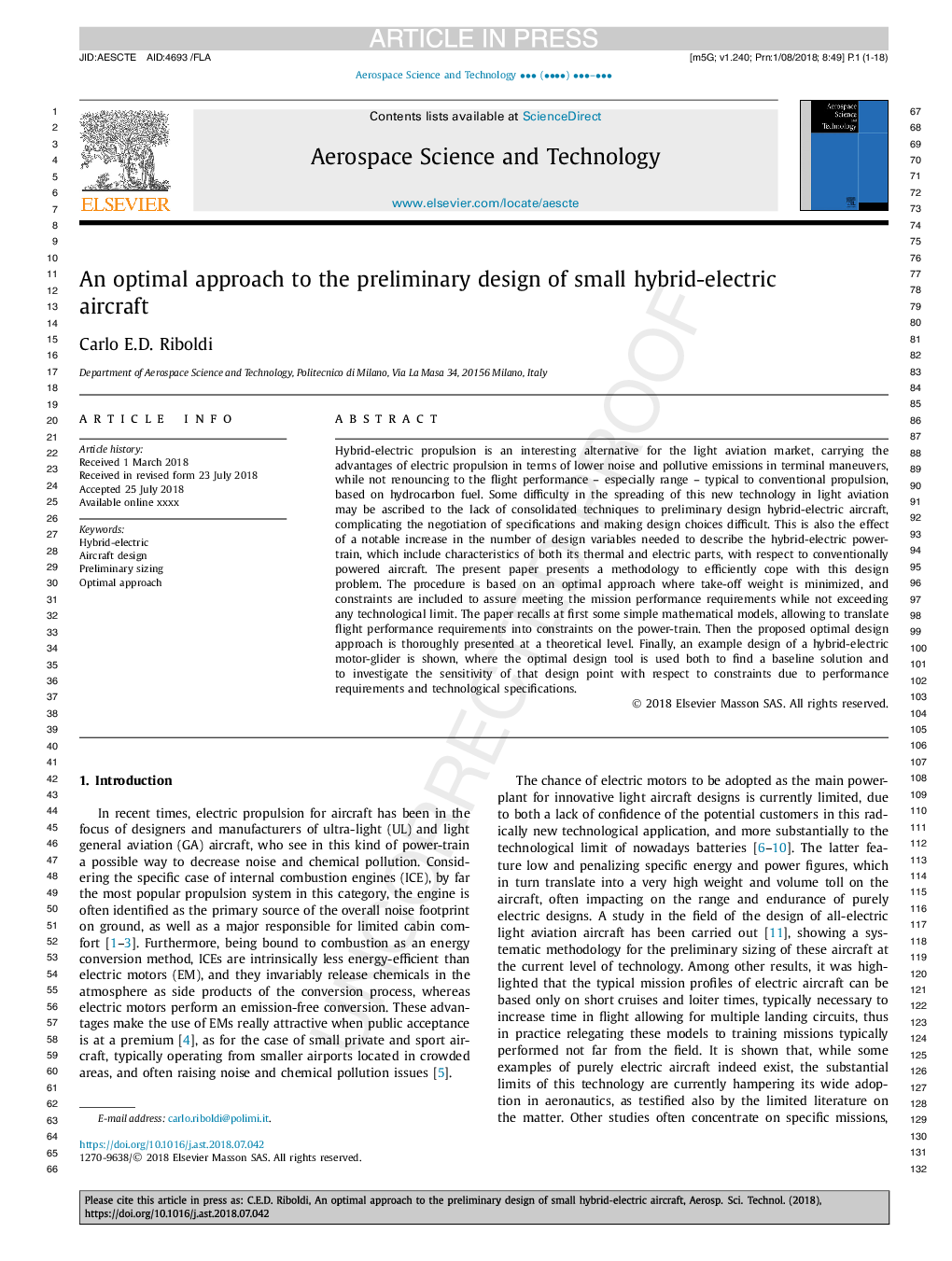| کد مقاله | کد نشریه | سال انتشار | مقاله انگلیسی | نسخه تمام متن |
|---|---|---|---|---|
| 8057173 | 1520053 | 2018 | 18 صفحه PDF | دانلود رایگان |
عنوان انگلیسی مقاله ISI
An optimal approach to the preliminary design of small hybrid-electric aircraft
ترجمه فارسی عنوان
یک رویکرد بهینه برای طراحی اولیه هواپیمای کوچک هیبریدی الکتریکی
دانلود مقاله + سفارش ترجمه
دانلود مقاله ISI انگلیسی
رایگان برای ایرانیان
کلمات کلیدی
ترکیبی الکتریکی، طراحی هواپیما، مقیاس اولیه رویکرد بهینه،
ترجمه چکیده
نیروی هیبرید الکتریکی یک جایگزین جالب برای بازار حمل و نقل هوایی نور است که مزایای موتور الکتریکی را از لحاظ کاهش نویز و انتشار آلودگی در مانورهای ترمینال حمل می کند، در حالی که از عملکرد پرواز - به ویژه محدوده - معمولی برای نیروی معمولی، بر اساس سوخت هیدروکربن. بعضی از مشکلات در گسترش این فناوری جدید در هواپیمایی سبک، ممکن است ناشی از فقدان تکنیک های تلفیقی هواپیمای هیبریدی الکتریکی طراحی اولیه، پیچیده بودن مذاکره در مورد مشخصات و ساختن انتخاب طراحی باشد. این نیز اثر افزایش قابل توجهی در تعداد متغیرهای طراحی مورد نیاز برای توصیف نیروی هیبریدی برق است که شامل ویژگی های هر دو قسمت حرارتی و الکتریکی آن با توجه به هواپیما معمولی طراحی شده است. در این مقاله روشی برای مقابله با این مشکل طراحی ارائه شده است. این روش بر اساس یک رویکرد بهینه ای است که در آن وزن وزن کم کم می شود و محدودیت هایی برای اطمینان از نیازهای عملیاتی ماموریت در نظر گرفته شده است، در حالی که هیچگونه محدودیت تکنولوژیکی از بین نمی رود. این مقاله در ابتدا برخی از مدل های ریاضی ساده را به یاد می آورد که اجازه می دهد الزامات عملکرد پرواز را در محدودیت های نیروی برق ترجمه کند. سپس رویکرد طراحی مطلوب طراحی به طور کامل در سطح نظری ارائه شده است. در نهایت، یک مثال از یک موتور الکتریکی هیبریدی الکتریکی نشان داده شده است که در آن ابزار طراحی بهینه برای یافتن راه حل پایه و بررسی حساسیت نقطه طراحی با توجه به محدودیت ها به دلیل الزامات عملکرد و مشخصات فنی مورد استفاده قرار می گیرد.
موضوعات مرتبط
مهندسی و علوم پایه
سایر رشته های مهندسی
مهندسی هوافضا
چکیده انگلیسی
Hybrid-electric propulsion is an interesting alternative for the light aviation market, carrying the advantages of electric propulsion in terms of lower noise and pollutive emissions in terminal maneuvers, while not renouncing to the flight performance - especially range - typical to conventional propulsion, based on hydrocarbon fuel. Some difficulty in the spreading of this new technology in light aviation may be ascribed to the lack of consolidated techniques to preliminary design hybrid-electric aircraft, complicating the negotiation of specifications and making design choices difficult. This is also the effect of a notable increase in the number of design variables needed to describe the hybrid-electric power-train, which include characteristics of both its thermal and electric parts, with respect to conventionally powered aircraft. The present paper presents a methodology to efficiently cope with this design problem. The procedure is based on an optimal approach where take-off weight is minimized, and constraints are included to assure meeting the mission performance requirements while not exceeding any technological limit. The paper recalls at first some simple mathematical models, allowing to translate flight performance requirements into constraints on the power-train. Then the proposed optimal design approach is thoroughly presented at a theoretical level. Finally, an example design of a hybrid-electric motor-glider is shown, where the optimal design tool is used both to find a baseline solution and to investigate the sensitivity of that design point with respect to constraints due to performance requirements and technological specifications.
ناشر
Database: Elsevier - ScienceDirect (ساینس دایرکت)
Journal: Aerospace Science and Technology - Volume 81, October 2018, Pages 14-31
Journal: Aerospace Science and Technology - Volume 81, October 2018, Pages 14-31
نویسندگان
Carlo E.D. Riboldi,
